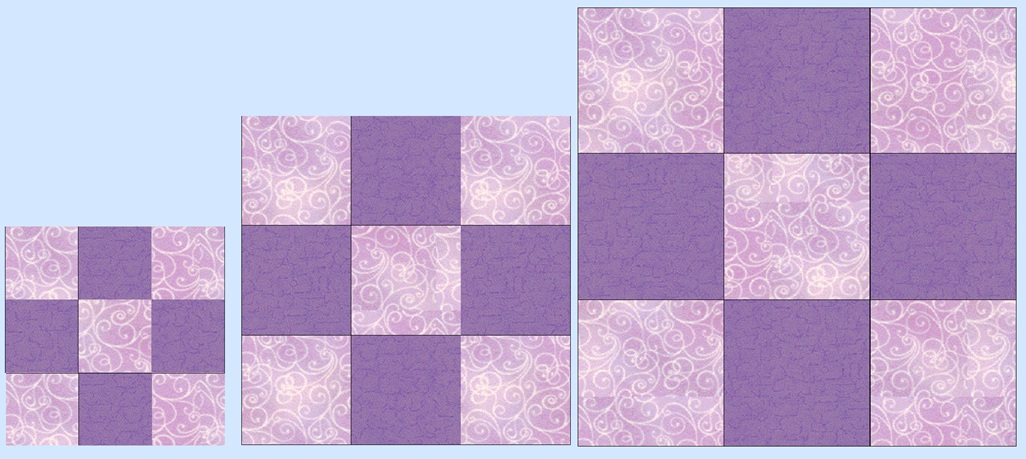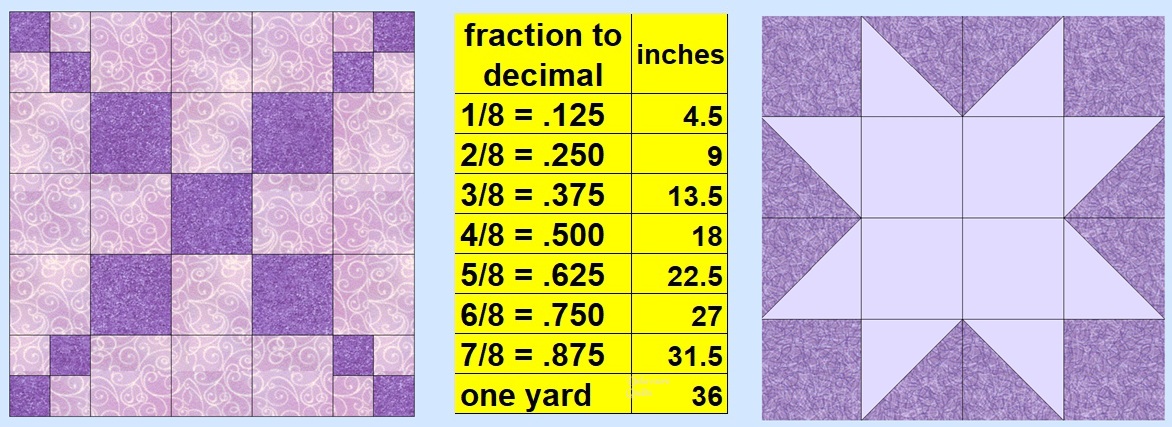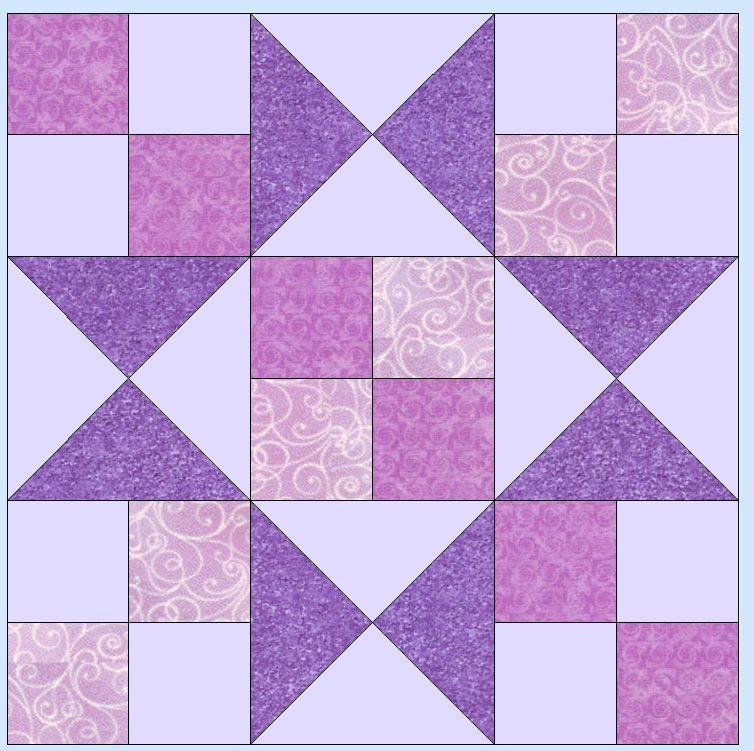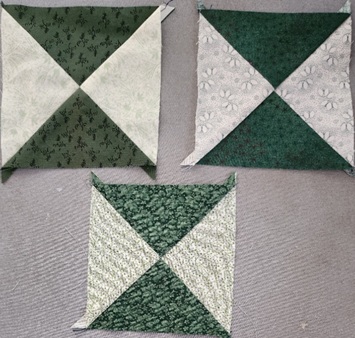 |
Some Math of Quilting |
My first quilting project had diamonds in it, diamonds. Anyone can tell you that is not a good project for a starting quilter, and I soon realized that myself. (I didn't know about templates or anything else.) I learned the hard way, but I learned. If you look at the quilts page, you will see that Lone Star project and many other of my beginning projects, lots of squares.
So let's talk about squares, an easy thing to figure the math of. A simple nine patch block, all squares. The diagram below shows three nine patch blocks, a six, a nine and a twelve inch. Three identical blocks, all made the same but different.

For all three blocks you need five light squares and four dark squares. For the 12 inch block you might say there are 3 in each row, so 12 divided by 3 equals 4 and cut 4 inch squares. If you do, you wouldn't get a 12 inch block. What you really need is a 12 1/2 inch block, because you need a seam allowance.
Lets start over with that 12 1/2 inch block. Yes, you need 3 squares. But you need them for a 12 1/2 inch block, and those little squares need seam allowances also. 12 inches divided by 3 equals 4 inches. 4 inches plus 1/2 inch (1/4 for each side) equals 4 1/2 inches. So to make a 12 1/2 inch unfinished nine patch quilt block you need to cut 4 1/2 inch squares.
When it is finished meaning in the block, it will measure 4 inches.
How about the 6 inch finished nine patch block? 6 plus seam allowances equals 6 1/2 inches. 6 divided by 3 equals 2 plus 1/2 inch for seam allowance equals 2 1/2 inches. For the 6 inch finished nine patch quilt block you need to cut 2 1/2 inch squares.
What about a block that has more than nine segments, like this Single Chain and Knot, the block below? That block has five rows across and up and down. A 12 inch finished single chain has 5 segments or units. 12÷5=2.4 2.4+.5=2.9 Confused? OK, first we've converted to decimals, that makes it easier than dealing with fractions in the math of quilting some of the time, like this case. The diagram shows what each fraction measurement equals in decimals. So 1/2 becomes .5, 3/4 is now .75. But that .9, well that isn't even on the chart is it? In this case, and in many others were just squares go, you could cut 3 inch segments which is what is the correct measurement. How do I know? Math.

What about that sawtooth star, it has triangles? Ok, moving on to triangle half squares or diagonal half squares. For diagonal half squares, the math gets a little more complicated. Remember "finished" size, this block is 9 inches. If you are making diagonal half squares to put in a "finished" nine-patch square, you will need those diagonal half squares to measure 3 1/2 when you are done. But because your diagonal half squares will have a seam in them, going diagonally from corner to corner, you have to add a seam allowance in them as well. You add 3/8 for this seam allowance. Your squares to make diagonal half squares from should be cut 3 7/8 inches. (3 1/2 + 3/8 = 3 7/8)
 |
 Here's another one for you, quarter square triangles, such as in this 12 inch Ohio star chain. Now you are cutting your square unit in half diagonally twice. The math for those is the same only this time, because you are cutting twice, you need a little more. Some people say you add 1 inch. Other people say you add 1 1/4 inches and I even found a tutorial on line that suggested you add 1 1/2 inches and cut it back. And the math.. Let's test that math now. What I suggest is that you test your quarter square triangles with scrap fabric first before you cut out a whole quilts worth and have a wrong measurement. Personally when I make mine, I add 3/4 inches. Why? My thought process was that you add 3/8 for the first diagonal seam allowance, why not another 3/8 for the second seam allowance. That number has worked for me in the past. |
| NOTE - it had been a while, years, since I'd made a quarter square triangle. so I went in the sewing room, dug out some scraps, and made three. I made one 1 1/4 inch larger than needed, one 1 inch larger than needed and finally one 3/4 larger than needed. I made the one I was sure would be right first and it wasn't. However that was because I hadn't checked my seam allowances, and I was sewing at a much larger than needed. That only affected the two quarter square triangles when I sewed them togther, since I had marked the lines for the other seams. When I took those apart and resewed them, they were a perfect 4 1/2 inches. The other two units were larger than needed, but could be trimmed down to 4 1/2 inches if I was using them. (They will all go in my orphan block box) So do what I suggested, and make your own test quarter square triangles to be sure. Actually, that's good advice for almost anything new in quilting. Better safe than sorry, with the cost of fabric these days. It is better to make a trial block or difficult unit of a block from scraps than to ruin your good fabric. And you can always put that trial in your “use later” box for a scrappy quilt. |
 |
Happy quilting, and thank your math teacher next time you see him or her.
Posted October 26, 2025
|Home| Quilts| Email|